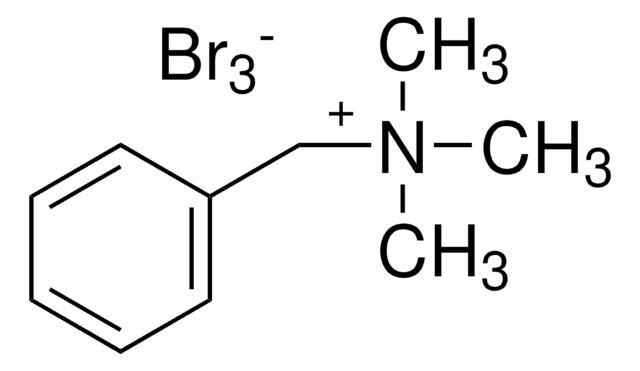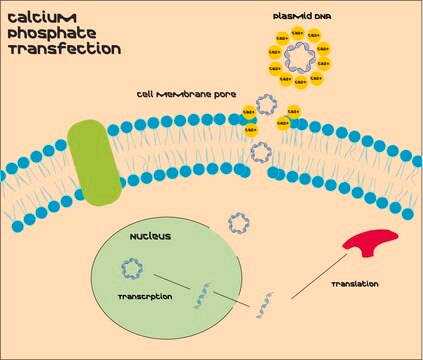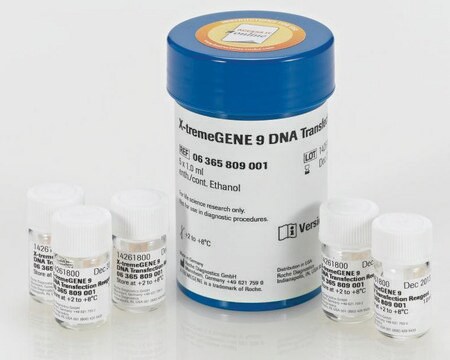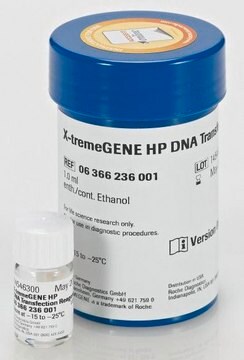11202375001
Roche
DOTAP Liposomal Transfection Reagent
>99% (TLC), liquid, suitable for transfection
Synonyme(s) :
DOTAP methosulfate, liposomal transfection reagent, dotap, transfection reagent, dotap, N-(2,3-Dioleoyloxy-1-propyl)trimethylammonium methyl sulfate, Transfection reagent
About This Item
Produits recommandés
Description
N-[1-(2,3-Dioleoyloxy)propyl]-N,N,N-trimethylammonium methyl-sulfate
Niveau de qualité
Essai
>99% (TLC)
Forme
liquid
Conditionnement
pkg of 5 × 400 μL (10 U/μl)
Fabricant/nom de marque
Roche
Technique(s)
transfection: suitable
Température de stockage
2-8°C
Chaîne SMILES
[H]C(C[N+](C)(C)C)(OC(CCCCCCC/C=C\CCCCCCCC)=O)COC(CCCCCCC/C=C\CCCCCCCC)=O.O=S([O-])(OC)=O
InChI
1S/C42H80NO4.CH4O4S/c1-6-8-10-12-14-16-18-20-22-24-26-28-30-32-34-36-41(44)46-39-40(38-43(3,4)5)47-42(45)37-35-33-31-29-27-25-23-21-19-17-15-13-11-9-7-2;1-5-6(2,3)4/h20-23,40H,6-19,24-39H2,1-5H3;1H3,(H,2,3,4)/q+1;/p-1/b22-20-,23-21-;
Clé InChI
RSMRWWHFJMENJH-LQDDAWAPSA-M
Vous recherchez des produits similaires ? Visite Guide de comparaison des produits
Catégories apparentées
Description générale
Application
Caractéristiques et avantages
- Easy to use: The lipid dispersion is simply mixed with the DNA solution, then applied directly to the cells
- Highly effective: 5 to 100-fold more effective than the calcium phosphate or DEAE-dextran method
- Gentle: No cytotoxic effects
- Flexible: Equally effective in the presence or absence of serum. Effective on a wide range of species (e.g., insect cells, mammalian cells) and a variety of different cell types. Can be used for either transient or stable transfection procedures.
- Aqueous dispersion (liposomes) in MBS (MES-buffered saline, pH 6.2) (bottled under argon), 1mg/ml, sterile-filtered.
Notes préparatoires
The optimal working concentration is dependent on several parameters, including the cell line being used, concentration and type of nucleic acid (DNA, RNA), and incubation time. It is important to optimize the transfection conditions for the individual cell type studied.
Cytotoxicity: Not cytotoxic up to a concentration of 100μg/ml (PBLs, HeLa cells).
Autres remarques
Code de la classe de stockage
12 - Non Combustible Liquids
Classe de danger pour l'eau (WGK)
nwg
Point d'éclair (°F)
does not flash
Point d'éclair (°C)
does not flash
Faites votre choix parmi les versions les plus récentes :
Déjà en possession de ce produit ?
Retrouvez la documentation relative aux produits que vous avez récemment achetés dans la Bibliothèque de documents.
Les clients ont également consulté
Articles
This brief webinar provides an overview of what transfection is and the methods that are used to introduce DNA or RNA into eukaryotic cells.
Notre équipe de scientifiques dispose d'une expérience dans tous les secteurs de la recherche, notamment en sciences de la vie, science des matériaux, synthèse chimique, chromatographie, analyse et dans de nombreux autres domaines..
Contacter notre Service technique

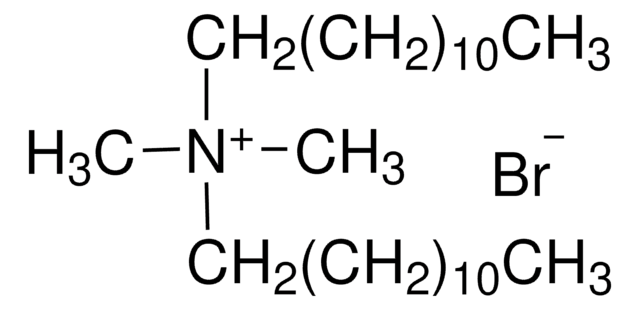



![Fluorescent DOTAP 1-oleoyl-2-[6-[(7-nitro-2-1,3-benzoxadiazol-4-yl)amino]hexanoyl]-3-trimethylammonium propane (chloride salt), powder](/deepweb/assets/sigmaaldrich/product/structures/262/741/3634e622-7f85-4907-beb5-5f2137c95947/640/3634e622-7f85-4907-beb5-5f2137c95947.png)


